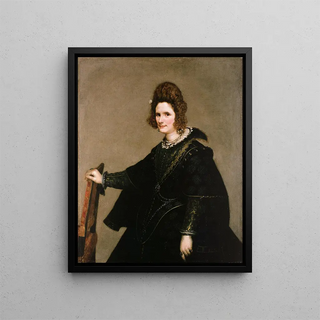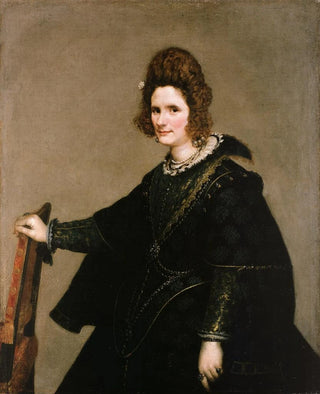Art print | Portrait of a lady - Diego Velázquez Source: Reproduction | Portrait d'une dame - Diego Velázquez


View from behind

Frame (optional)
Portrait of a Lady - Diego Velázquez – Captivating Introduction
The "Portrait of a Lady" by Diego Velázquez is an iconic work that embodies the artistic genius of one of the masters of Spanish baroque. Painted in the 17th century, this painting not only showcases Velázquez's exceptional talent but also reflects the richness and complexity of portraits from that era. This masterpiece, full of subtlety and elegance, immerses the viewer in a universe where light and shadow intertwine to reveal the personality of the depicted figure. The art print of this painting allows appreciation of the psychological depth and fine details that make this work a cornerstone of art history.
Style and uniqueness of the work
The work stands out for its unique approach to portraiture, blending realism and idealization. Velázquez, with his inimitable style, manages to capture not only the appearance of the lady but also her essence. The composition is carefully orchestrated, with delicate colors and meticulously rendered textures. The lady's gaze, both gentle and penetrating, creates a connection with the viewer, inviting introspective contemplation. The drapery of her dress, painted with remarkable virtuosity, adds a tactile dimension to the work, making the luxury and nobility of the figure almost palpable. This technical mastery, combined with emotional sensitivity, gives the portrait a depth that transcends mere visual rendering.
The artist and his influence
Diego Velázquez, born in 1599 in Seville, is often regarded as one of the greatest painters in the history of Western art. His artistic journey is marked by an unceasing quest for truth and beauty, reflected in each of his works. Velázquez established himself at the court of the Habsburgs, becoming the official painter of Philip IV of Spain. His influence extends far beyond his time, inspiring generations of artists, from Impressionists to modernists. His innovative approach to portraiture, which combines realism and psychology, paved the way for new forms of artistic expression. By redefining the codes of portraiture, he enabled his contemporaries and those who followed to explore

Matte finish

View from behind

Frame (optional)
Portrait of a Lady - Diego Velázquez – Captivating Introduction
The "Portrait of a Lady" by Diego Velázquez is an iconic work that embodies the artistic genius of one of the masters of Spanish baroque. Painted in the 17th century, this painting not only showcases Velázquez's exceptional talent but also reflects the richness and complexity of portraits from that era. This masterpiece, full of subtlety and elegance, immerses the viewer in a universe where light and shadow intertwine to reveal the personality of the depicted figure. The art print of this painting allows appreciation of the psychological depth and fine details that make this work a cornerstone of art history.
Style and uniqueness of the work
The work stands out for its unique approach to portraiture, blending realism and idealization. Velázquez, with his inimitable style, manages to capture not only the appearance of the lady but also her essence. The composition is carefully orchestrated, with delicate colors and meticulously rendered textures. The lady's gaze, both gentle and penetrating, creates a connection with the viewer, inviting introspective contemplation. The drapery of her dress, painted with remarkable virtuosity, adds a tactile dimension to the work, making the luxury and nobility of the figure almost palpable. This technical mastery, combined with emotional sensitivity, gives the portrait a depth that transcends mere visual rendering.
The artist and his influence
Diego Velázquez, born in 1599 in Seville, is often regarded as one of the greatest painters in the history of Western art. His artistic journey is marked by an unceasing quest for truth and beauty, reflected in each of his works. Velázquez established himself at the court of the Habsburgs, becoming the official painter of Philip IV of Spain. His influence extends far beyond his time, inspiring generations of artists, from Impressionists to modernists. His innovative approach to portraiture, which combines realism and psychology, paved the way for new forms of artistic expression. By redefining the codes of portraiture, he enabled his contemporaries and those who followed to explore






